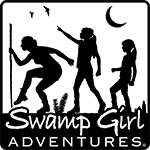Reptile rehabilitator Kim Titterington holds a successfully rehabilitated Eastern Indigo Snake before releasing it into the wild. Note the white scar tissue and irregularities in scale pattern due to his injuries. Photo by Laura Reed.
Authors: Laura Reed and Betsie Rothermel
Just before Christmas, Archbold Herpetology Program staff were happy to assist in returning a rehabilitated Eastern Indigo Snake to the wild. After being found badly injured in September in a densely populated area of Highlands County, the snake arrived at Swamp Girl Adventures Reptile Rehabilitation on September 24. Rehabilitator Kim Titterington remembers, “The snake arrived with traumatic injuries to his body, scabs and fresh scar tissue from what may have been an encounter with lawn equipment. The injuries were healing fairly well, but the scar tissue was tight and dry, constricting his midsection.” The snake was also dehydrated and unable to hunt and eat enough food to maintain a healthy body weight while healing.
Every individual Eastern Indigo Snake is important for survival of the species. As Archbold’s Director of Herpetology, Betsie Rothermel, explains, “Eastern Indigos have been extirpated from some parts of their former range, such as the Florida Panhandle, and are declining in most other areas as urbanization reduces their upland habitats. Though the southern Lake Wales Ridge region is still home to relatively healthy populations, their future is by no means secure given future projections of human population growth and development.” Thus, Eastern Indigos are federally designated as Threatened and protected in Florida.
Titterington and staff went to work to save this snake, providing it with fluids, antibiotics, and lots and lots of food. During the four months of rehab, the snake gained almost 200 grams in body weight and grew almost four inches! The team confirmed he was eating, shedding, and gaining weight, then consulted with the US Fish and Wildlife Service (USFWS) and Florida Fish and Wildlife Conservation Commission (FWC) to determine if he was fit for release, rather than live a life in captivity. All deemed the snake fit to survive and thrive in the wild, and Titterington contacted Dr. Rothermel to discuss release.
Since the snake would face too many dangers in its former home, Dr. Rothermel assisted rehabilitators in finding a safer location. After four months in rehab, the scarred but healthy Indigo traveled back to Highlands County on December 20. The group traveled deep into the scrub on protected land far from any roads and said their goodbyes. It was a bittersweet moment as they watched the snake explore his new home, then disappear into the palmettos. Kim Titterington remarked, “I never thought I’d see an Indigo come into rehabilitation. I am so thankful we could save him and release an endangered species back into the wild!”
Eastern Indigos are large animals that require large, roadless spaces to roam. They can reach more than 8 feet in length, making them the longest snake in North America. Though nonvenomous, they are top predators, hunting and consuming a wide variety of small mammals and other reptiles, including many other snakes.
Swamp Girl Adventures Reptile Rehabilitation (www.swampgirladventures.org) is a licensed wildlife rescue team focused on the care of reptiles and amphibians, as well as educating the public about wildlife through educational programs and videos. “Archbold does not have the specially trained staff and facilities needed to treat and rehabilitate injured wildlife,” explains Dr. Rothermel, “so we are very grateful for people like Kim who are dedicated to this important work.” If you come across injured reptiles or other wildlife, check this website to find a wildlife rehabilitator who can help: https://myfwc.com/media/5423/licensedwildliferehabilitatorsbyregion.pdf
The specific release location is undisclosed because of the species’ protected status. Eastern Indigo Snakes may only be handled by individuals with appropriate scientific research or other permits. However, members of the public are encouraged to contribute sightings of Eastern Indigo Snakes to FWC’s Rare Snake Registry (https://public.myfwc.com/fwri/raresnakes/UserHome.aspx?id=) where you can also report sightings of other upland species, like Southern Hognose Snakes and Florida Pine Snakes. For more info on Eastern Indigos, visit: https://www.oriannesociety.org/about/the-eastern-indigo-snake/
https://archboldedublog.org/2021/01/14/a-second-chance-for-an-injured-indigo/


